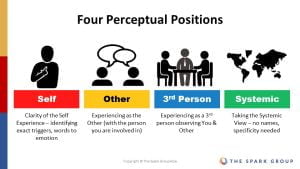
“AGE HAS NOTHING TO DO WITH LEADERSHIP MATURITY”
We can meet 60-year-olds in business for 40 years and still behave as if the world revolves around them, and we meet people in their 20s who can solve problems in a level-hearted manner.
Leadership and problem-solving maturity have to do with the ability to take more than one position in adversity, meaning being able to check in with all Points of View (POV), instead of just one, or theirs.
The Four Perceptual Positions, that we teach leaders to use in The Leadership Matrix Program, address the narrow views of people when conflicts or challenges occur.
One of my clients had a long-serving employee who committed the mistake of promoting his side business to current clients of the company and was caught doing so as clients had filed complaints. The CEO had to assume 4 Perceptual Positions, to handle the situation rationally, as the situation was escalating and obviously a breach of trust and confidentiality. She was able to manage the situation calmly, also wearing the shoes of the employee, and ensured that the situation was resolved quickly and professionally.
The Four Perceptual Positions is a model developed in the field of Neuro-Linguistic Programming (NLP) that involves changing perspectives to gain a better understanding of a situation or problem.
The four positions are:
- First position – Self: This is the perspective of oneself, where the individual experiences the situation or problem from their own point of view. This involves being fully present and experiencing the situation through one’s own senses and emotions.
Advantages of 1st position: able to identify how one feels, and process of experience.
Disadvantages: Can take problems too personally, if over-indulged in 1st
- Second position – Other: This is the perspective of another person involved in the situation or problem. This involves putting oneself in another person’s shoes and trying to see the situation from their point of view.
Advantage: Had empathy, and can see the other person’s situation.
Disadvantage: When 2nd position is taken without proper balance with other positions, there is a possibility of losing one-self, during adversity.
- Third position – 3rd person: This is an objective perspective, where the individual views the situation as a detached observer. This involves stepping back and observing the situation as if from the outside, without any emotional involvement.
Advantage: Able to remove self from the problem, and depersonalize the problem.
Disadvantage: Can appear removed, and involved from the situation.
- Fourth position – Systemic: This is the perspective of a “meta-observer”, where the individual observes the relationship between the first, second, and third positions. This involves stepping back even further and observing the dynamics and interactions between the different perspectives.
Advantage: Can see the logical view of problems, and rationalize quickly. Reduce emotional attachments. Can act quickly.
Disadvantage: Can seem removed, and extremely logical, reducing perceived empathy in the situation.
By switching between these four perceptual positions, individuals can gain a more comprehensive understanding of a situation or problem, and develop greater empathy and perspective-taking abilities. This can be particularly useful in conflict resolution, communication, and personal development.
Four Perceptual Positions is a processing tool, especially in situations when the problems are intense and very stressful.
We encourage leaders to use this tool to pause and process, without acting rashly in situations that call for their best judgment.
Hope this helps!
Want to learn The Four Perceptual Positions and More?




